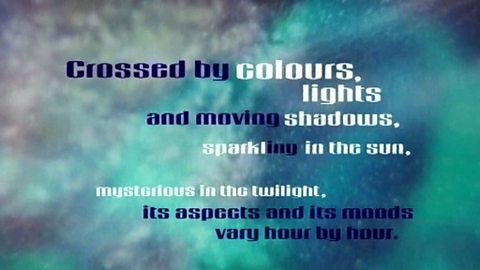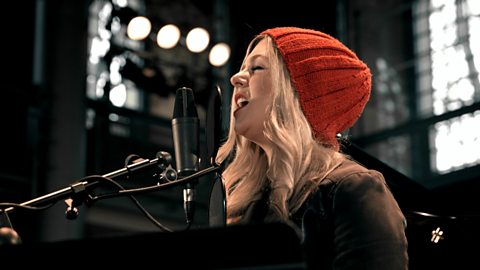Apostrophes
Ahmed's adventure involves several armies, a rickety bridge and a lesson in apostrophes.
In this animated film Ahmed's latest adventure takes an alarming turn involving several armies, a rickety bridge and a lesson in apostrophes.
Constructing sentences
Close textual analysis reveals how sentences can be consciously constructed for effect.
This clip featuring language from Rachel Carson's 'The Sea Around' shows how, through close textual analysis at sentence level, a writer can consciously craft sentences to convey meaning to the reader.
Exploration of language at word and sentence level
Trevor McDonald explains why an extract from 'Out of India' has an impact on him.
Trevor McDonald's explanation as to why he enjoys and can identify with an extract from Jamila Gavin's 'Out of India' shows how writers can bridge the gap between what they write and how the reader reads it. McDonald focuses on word and sentence level features, describing how the language conveys images, how the use of repetition provides a poetic quality and rhythm to the extract and how the sentence variety is key to the impact of the piece.
How persuasive techniques can have an effect in a range of texts
Singer Jem explores persuasive writing devices and the effect of these in her writing.
Jem, a singer-songwriter, discusses some of her own lyrics and performs with piano accompaniment. She explains how through one song in particular she explores the effect of persuasive writing techniques used by advertisers and speechwriters. She compares songwriting to these other text forms and discusses how, although not always to the same effect, songwriters use the same techniques, eg imagery, rhythm, repetition, direct quotation. She mentions key slogans like ‘buy one get one free’ and the opening to Martin Luther King’s famous speech, ‘I have a dream’ and talks about her own writing process.
How stories are adapted for a young audience
An insight into the making of CBBC’s Newsround.
An insight into the making of CBBC’s Newsround.
Journalist Tina Daheley explores how Newsround, which started in 1972, presents the news for its young audience.
She speaks to reporter Ricky Boleto at the CBBC Newsround studios and asks how he makes news stories appropriate for six to twelve year olds. They talk about the importance of explaining everything in a story and not assuming that the audience knows anything about the details.
Using an example of a news item about Donald Trump winning the US election, Tina and Ricky explain how Newsround reporters simplify complex news stories for their audience. They also discuss the use of friendly and informal language and short concise sentences that are easy for children to understand.
Newsround’s intention is that news stories will be shared by young viewers and the language that reporters use supports this. Daheley and the Newsround reporter focus on the use of specific words in the bulletin and look at the effect of specific adjectives. The effect of words with impact and describing words are shown through real examples. The clip also focuses on the use of opinions and vox-pops in Newsround and explores how interviews with children and young people are used to reflect and appeal to the young audience. As with adult news, both sides of an argument are presented.
They look at the use of puppets and animation to bring Newsround’s stories to life. A comparison between the Newsround and main news handling of the Donald Trump inauguration story is used to highlight how the programmes present the same story in different ways.
How to draft and redraft writing to improve vocabulary and structure
Rapper Double S models how he redrafts to improve vocabulary, grammar and structure.
Writer and rapper, Double S, explains how he improvises a first draft and then thinks about how it can be improved. His drafting is a semi- performance to a simple beat. He tests how the lines, which appear on the screen as he speaks them, sound when rapped and takes feedback from his producers. He discusses how he might change words and word order so that the vocabulary and structure of the writing communicates his meaning clearly and with impact.
How to write a news report
Journalist Tina Daheley looks at how English language is used when writing news stories.
Journalist Tina Daheley demonstrates English language techniques as she prepares a TV news bulletin about American President, Donald Trump's immigration ban.
How varying sentence structure creates different effects in a poem
Singer Jem explains how she considers sentence type and structure when writing a song.
Singer-songwriter Jem models the process she uses to refine song lyrics. She discusses how initial ideas are likely to be in simple sentences and how and when she might choose to make these compound or complex. Sentences appear as onscreen captions as she reads them. Key words including grammar, tense, punctuation, subject, verb, and object also appear on screen as Jem uses these in her explanations. She explores how sentence structure can affect emphasis and intonation and how the written word changes when it becomes spoken or sung. Accompanied by a pianist, Jem tries out the reworked lines.
An exploration of how punctuation is essential for the reader/speaker/listener.
Through role play, demonstration and modelling, the importance of punctuation in both speech and writing is explored. The clip looks at the use of a wide range of punctuation marks, including exclamation marks, colons, semi-colons, question marks, dashes and commas. Through modelling, the use of punctuation as signposts is explored, so that readers can be helped to navigate their way through, and make meaning of, a text. The impact of a lack of punctuation in speech is also discussed.
Register
Follow Monty Huntington-Smythe and Percy Octavius’s as they get to grips with register.
In this animated film, learning about register is a rollercoaster ride for Monty Huntington-Smythe and Percy Octavius.
Speech marks
Follow Rachel Reporting’s adventures and mishaps as she gets to grips with speech marks.
In this animated film, Rachel Reporting keeps us updated on Banktastrophe's collapse whilst learning about speech marks.
Using Scots words to create a menacing atmosphere
John Michie investigates how Scots words add more atmosphere to the crime genre.
John Michie suggests that many Scots words can send a chill down your spine. Words like 'mirk', 'smoored', and 'thrappled' and the phrase ‘Howe Dumb Dead’ combine to link crime and murder with traditional Scottish language.
More on Writing skills
Find out more by working through a topic
- count1 of 7

- count2 of 7

- count3 of 7
